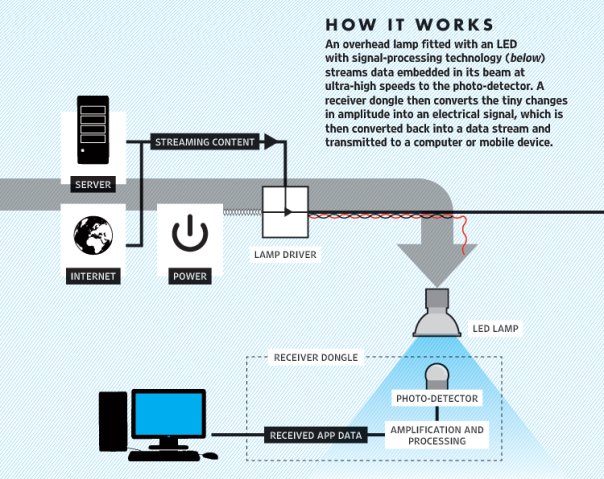 Hello folks,this is Ravi and I am here with you to throw light on a latest technology named Li-Fi.We are in 21st century,where Internet has become common,Whether we are using wireless internet in a coffee shop,competing for bandwidth at a conference,downloading and all.But what if internet speed is slow ? ? ? We get frustrated. Don’t we ? ?
Hello folks,this is Ravi and I am here with you to throw light on a latest technology named Li-Fi.We are in 21st century,where Internet has become common,Whether we are using wireless internet in a coffee shop,competing for bandwidth at a conference,downloading and all.But what if internet speed is slow ? ? ? We get frustrated. Don’t we ? ?
Li-Fi, which is short for light fidelity, the technology is what is known as Visible Light Communication (VLC) developed by a team of scientists including Dr Gordon Povey, Prof. Harald Haas and Dr Mostafa Afgani at the University of Edinburgh.Li-Fi could lead to the Internet of Things, which is everything electronic being connected to the internet, with the LED lights on the electronics being used as Li-Fi internet access points. LED has become more than a way to throw out light, but to double-up as a super-fast multi-channel highway of data through Visible Light Communication (VLC), and hence the future replacement for WiFi.
Li-fi uses light instead of radio waves to transmit information.And instead of Wi-Fi modems, Li-Fi would use transceiver-fitted LED lamps that can light a room as well as transmit and receive information. Since simple light bulbs are used, there can technically be any number of access points.It is possible to encode data in the light by varying the rate at which the LEDs flicker on and off to give different strings of 1s and 0s. The LED intensity is modulated so rapidly that human eyes cannot notice, so the output appears constant.
How it Works:-
 Visible light is part of the electromagnetic spectrum and 10,000 times broader than the radio spectrum, affording potentially unlimited capacity. Existing LED light bulbs could be converted to transmit LiFi signals with a single microchip and span an entire home or office, making timing-out and signal interference typical of radio wave wireless networking a thing of the past – and vastly increasing the speed of data transmission.Such advancements promise a theoretical speed of 10 Gbps – meaning one can download a full high-definition film in just 30 seconds.
Visible light is part of the electromagnetic spectrum and 10,000 times broader than the radio spectrum, affording potentially unlimited capacity. Existing LED light bulbs could be converted to transmit LiFi signals with a single microchip and span an entire home or office, making timing-out and signal interference typical of radio wave wireless networking a thing of the past – and vastly increasing the speed of data transmission.Such advancements promise a theoretical speed of 10 Gbps – meaning one can download a full high-definition film in just 30 seconds.
Drawbacks to the technology include the need for a clear line of sight, difficulties with mobility and the requirement that lights stay on for operation.
If you enjoyed this Post, I’d be very grateful if you’d help it spread by emailing it to a friend, or sharing it on social network.Thank you ! keep hitting…